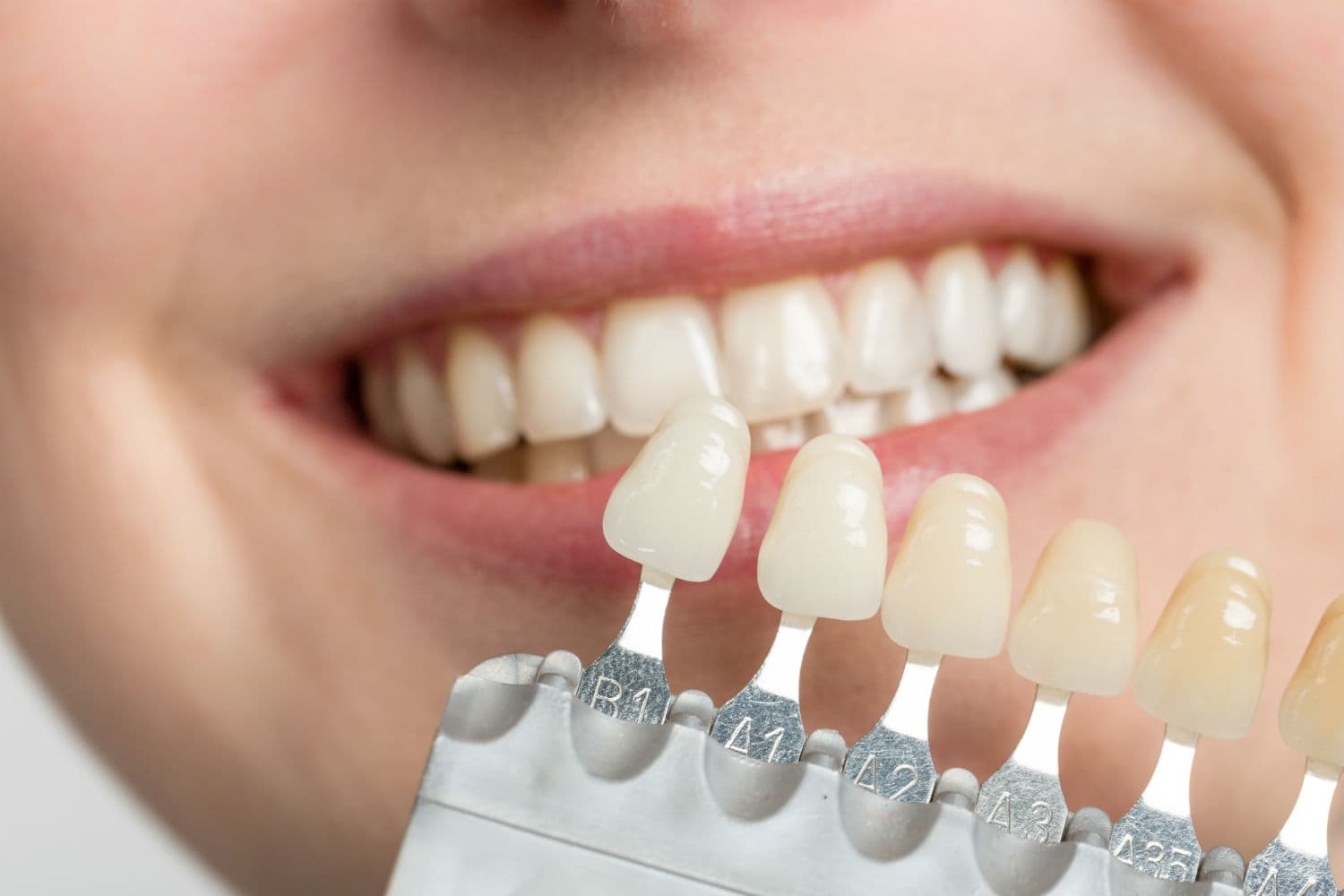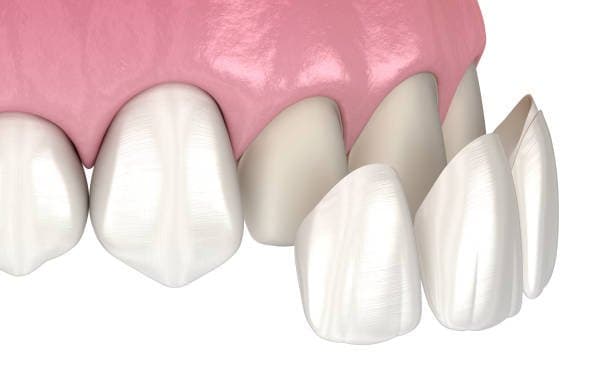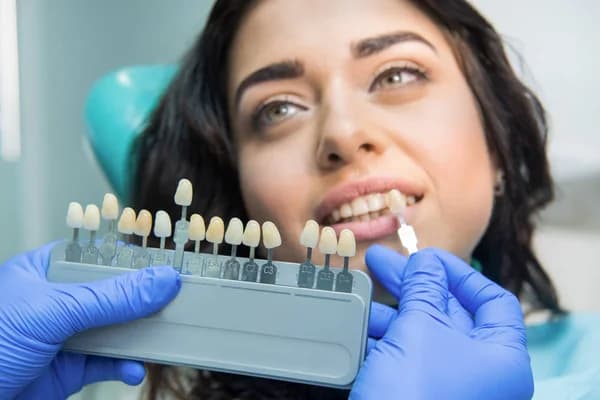Dental crowns and veneers are two popular restorative and cosmetic dental procedures that enhance the appearance and function of teeth. While both treatments aim to improve dental aesthetics and restore damaged teeth, they differ significantly in their application and benefits.
Veneers vs. Crowns
Veneers and crowns are both effective dental solutions, but they serve different purposes and involve distinct procedures. Veneers are thin, custom-made shells made of porcelain or composite resin that cover the front surface of teeth. They are primarily used for cosmetic purposes, such as correcting discoloration, minor chips, gaps, and misshapen teeth. Veneers require minimal tooth enamel removal, which makes the procedure less invasive. They provide a natural-looking, aesthetically pleasing result, especially for the front teeth. Veneers are ideal for patients seeking to enhance the appearance of their smile with minimal alteration to their natural teeth structure.
On the other hand, crowns, also known as caps, cover the entire tooth. They are used for teeth that are significantly decayed, damaged, or structurally compromised. Crowns can be made from various materials, including porcelain, ceramic, metal, and composite resins, providing substantial strength and durability. They are suitable for both front and back teeth and are often used to restore teeth after root canal treatment, support dental bridges, or protect weak teeth from fracturing. The process of getting a crown involves more extensive tooth preparation compared to veneers.

What is a Veneer?
A veneer is a thin, custom-made shell crafted from either porcelain or composite resin materials, designed to cover the front surface of teeth. Veneers are primarily used for cosmetic purposes to enhance the appearance of teeth that are discolored, chipped, misaligned, or have gaps between them. This dental solution offers a minimally invasive way to achieve a dramatic improvement in the aesthetics of one's smile.
Porcelain veneers are renowned for their ability to mimic the natural translucency and color of tooth enamel, providing a lifelike appearance. They are also highly stain-resistant, making them a long-lasting choice for patients who wish to maintain a bright, white smile. The process of getting porcelain veneers typically involves two to three visits to the dentist. During the first visit, the dentist will remove a small amount of enamel from the front of the teeth to create space for the veneers. Impressions of the teeth are then taken and sent to a dental lab, where the custom veneers are fabricated. In a subsequent visit, the veneers are bonded to the teeth using a special adhesive, resulting in a strong and aesthetically pleasing restoration.
Composite resin veneers, on the other hand, are typically applied in a single visit. The dentist layers the resin material directly onto the teeth, shaping and polishing it to achieve the desired look. While composite veneers are generally less expensive than porcelain veneers, they may not last as long and can be more susceptible to staining over time.
Veneers require minimal removal of the natural tooth structure, making them a conservative option compared to other restorative treatments like crowns. They are particularly effective for patients seeking to improve the appearance of their front teeth without undergoing extensive dental work. By providing a natural-looking and durable solution, veneers help patients achieve a confident and attractive smile.

Dental Veneer Procedure
The dental veneer procedure is a transformative process that enhances the appearance of teeth by covering the front surface with thin, custom-made shells. This procedure is primarily used to address cosmetic concerns such as discoloration, chips, misalignment, and gaps, resulting in a more attractive and confident smile.
The process typically begins with an initial consultation, where the dentist evaluates the patient's oral health, discusses their goals, and determines if veneers are the suitable option. If veneers are deemed appropriate, the dentist and patient will collaborate on selecting the most suitable shade and shape to achieve a natural and aesthetically pleasing result.
Once the decision is made, the first step involves preparing the teeth for the veneers. This preparation usually requires the removal of a small amount of enamel from the front surface of the teeth to ensure a proper fit and natural look. The amount of enamel removed is minimal, typically less than a millimeter, preserving as much of the natural tooth structure as possible.
After the teeth are prepared, the dentist takes precise impressions of them. These impressions are sent to a dental laboratory where the custom veneers are fabricated. The fabrication process may take a few weeks, during which the patient may receive temporary veneers to protect the prepared teeth and maintain their appearance.
Once the custom veneers are ready, the patient returns to the dentist for the final placement. The dentist first checks the fit and color of the veneers, making any necessary adjustments. The teeth are then cleaned, polished, and etched to create a suitable bonding surface. A special adhesive is applied to the veneers, which are then carefully positioned on the teeth. Once properly aligned, the veneers are bonded to the teeth using a curing light that activates the adhesive, securing them in place.
The final step involves removing any excess adhesive, polishing the veneers to achieve a natural look, and making any final adjustments to ensure the patient's bite is comfortable. With proper care, dental veneers can provide a durable and aesthetically pleasing solution, transforming the patient's smile for many years.

What is a Crown?
A dental crown is a protective cap that covers the entire visible portion of a tooth. It's used to restore the tooth's shape, size, strength, and appearance, especially when the tooth is severely damaged or decayed. Crowns are often recommended for teeth that cannot be effectively restored with fillings or other types of dental restorations due to extensive damage. They can be made from various materials, including porcelain, ceramic, metal, or a combination of these, each offering different benefits depending on the specific needs of the patient.
The procedure for placing a crown typically involves two dental visits. During the first visit, the dentist prepares the tooth by removing any decay and reshaping it to accommodate the crown. This may involve filing down the tooth or building it up with filling material if there's significant tooth loss. Once the tooth is prepared, an impression is taken to create a mold, which is then sent to a dental laboratory where the custom crown is fabricated. In the meantime, a temporary crown is placed to protect the prepared tooth.
During the second visit, the temporary crown is removed, and the permanent crown is checked for fit and color before being cemented in place. The dentist ensures that the crown fits comfortably and does not interfere with the patient's bite. Once the crown is cemented, it restores the tooth's functionality, allowing the patient to chew and speak normally.
Crowns offer several advantages, including providing structural support to weakened teeth, improving the appearance of discolored or misshapen teeth, and protecting teeth that have undergone root canal treatment. With proper care, dental crowns can last many years, providing a durable and aesthetically pleasing solution for restoring damaged teeth.

Dental Crown Procedure
The dental crown procedure is a comprehensive process designed to restore a damaged or decayed tooth to its optimal shape, size, strength, and function. This restorative treatment involves several key steps, typically spread over two dental visits.
During the first visit, the dentist begins by examining and preparing the tooth that will receive the crown. This preparation involves removing any decay and reshaping the tooth to ensure the crown will fit snugly. Depending on the extent of the damage, this may involve filing down the tooth or building it up with filling material if there has been significant tooth loss. The goal is to create a stable base for the crown.
Once the tooth is properly shaped, the dentist takes an impression of it, as well as the surrounding teeth, to ensure the new crown will fit seamlessly into the patient's bite. These impressions are sent to a dental laboratory, where skilled technicians craft a custom crown tailored to the patient's specific needs. The crown can be made from various materials, such as porcelain, ceramic, metal, or a combination, each offering different benefits in terms of strength and appearance.
While the permanent crown is being fabricated, the patient is fitted with a temporary crown to protect the prepared tooth. This temporary crown also allows the patient to continue normal eating and speaking functions without discomfort.
During the second visit, usually scheduled a few weeks later, the dentist removes the temporary crown and checks the fit and color of the permanent one. Adjustments are made if necessary to ensure a perfect fit. Once satisfied, the dentist cements the crown onto the prepared tooth using a strong dental adhesive. A special curing light may be used to harden the adhesive, ensuring a secure bond.
The final step involves polishing the crown and making any final adjustments to ensure the patient’s bite is comfortable and natural. With proper care and maintenance, dental crowns can last many years, providing a durable and aesthetically pleasing solution for restoring damaged teeth.
Pros and Cons of Veneers vs Crowns
Veneers and crowns are both popular dental restoration options, each with its own set of advantages and disadvantages.
Veneers are thin, custom-made shells of porcelain or composite resin designed to cover the front surface of teeth. One of the primary advantages of veneers is their ability to provide a highly aesthetic result, as they can be precisely matched to the color and shape of natural teeth. They require minimal removal of tooth enamel, preserving more of the natural tooth structure. Veneers are ideal for correcting cosmetic issues such as discoloration, minor chips, gaps, and misalignment. However, veneers are not suitable for severely damaged or decayed teeth, and they can be more prone to chipping or cracking compared to crowns. Additionally, veneers may need to be replaced after several years, especially if made from composite resin.
Crowns, on the other hand, cover the entire visible portion of a tooth, providing significant strength and durability. They are often recommended for teeth that are extensively damaged, decayed, or have undergone root canal treatment. Crowns can be made from various materials, including porcelain, ceramic, metal, or a combination, offering different levels of strength and aesthetic appeal. One of the main advantages of crowns is their ability to restore both the function and appearance of compromised teeth. They provide substantial protection and support, making them suitable for teeth subjected to heavy biting forces. However, crowns require more extensive tooth preparation, involving the removal of a larger amount of tooth structure. This can make the procedure more invasive compared to veneers. Additionally, crowns can be more expensive and may require multiple dental visits for placement.

Conclusion
In conclusion, both dental crowns and veneers serve as effective solutions for improving the appearance and functionality of teeth, but they cater to different needs. Veneers are ideal for patients seeking to address cosmetic issues such as discoloration, minor chips, and gaps with a minimally invasive procedure that preserves much of the natural tooth structure. On the other hand, dental crowns offer a more comprehensive restorative solution for teeth that are extensively damaged, decayed, or structurally compromised. Crowns provide significant strength and durability, making them suitable for both front and back teeth. Ultimately, the choice between veneers and crowns depends on the specific condition of the teeth, the desired aesthetic outcome, and the functional requirements.
Read More